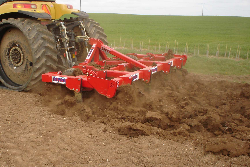
Growers planning to begin potato planting over the next month should ensure sub-surface compaction caused by plough panning and traffic is alleviated before bed preparations begin. That advice comes from machinery manufacturer SUMO, who adds that using a suitable deep-working cultivator can bring wet topsoil to the surface, aid drainage and ultimately improve tuber yields.
The firm's Stewart Peckitt warns that unless growers address problems caused by traffic damage and pans created just below ploughing depth, they could later face drainage problems once crops are established.
"While the old chisel plough type of cultivator has traditionally been used to solve this type of problem, more advanced, stronger and more versatile designs are now available," says Mr Peckitt.
"The Sumo Rippa can work down to 14-16in to remove plough pan compaction, and can be used in a variety of ways, from primary cultivation before ploughing and bed preparation, to compaction alleviation after potato harvesting has been completed. Both practices improve soil structure and allow water to percolate through the soil profile.
"Using 30mm thick steel for the Rippa's three rows of 700mm long legs, mounted on a 150mm x 150mm x 10mm hot-formed steel frame, means the implement has a great deal more inherent strength than more basic designs. That's essential if growers are to make the most of high output tractors and get crops planted on time."
Terry Hopper, who manages 1,600ha from Low Mowthorpe, near Malton in Yorkshire, for Albanwise Ltd, now has two Sumo Rippas in his machinery fleet, and believes such implements are central to successful potato growing. The farm produces some 480ha of potatoes, 95% of which are for seed, including crisping varieties Rosetta and Saturna and processing types Desiree and Estima.
"The effectiveness of the Rippa over a subsoiler type of cultivator lies in the 45o angle of its legs and the way it lifts the soil without bringing sub-surface material to the upper soil profile," says Mr Hopper.
"Not only does it help us alleviate compaction by opening up the drainage in the soil profile, but after two 10in-deep passes, the second at an angle to the first, we can go straight in with a ridger, without any need for a bed tiller. And we can also use the same implement after harvesting to address harvester and trailer damage."
Mr Hopper's son Shaun is one of the team of tractor operators at Low Mowthorpe who worked with the farm's two Rippas in their first season of operation last year, and is very pleased with the machine's performance.
"Our 4m, 15-leg Rippa is operated behind a wheeled Fendt 900 series tractor - either a 926 or a 930 - while we pull our 6m model with a Challenger MT765," he says. "We also operate a Sumo Quatro cultivator, so we know the equipment is designed and built well.
"The standard 80mm points fitted to our Rippas barely showed any wear after their first season's work – and that's despite working down at 10in deep on our Wold land. But there's no doubt they have helped improve drainage and crop yields across our potato types," he concludes.
